
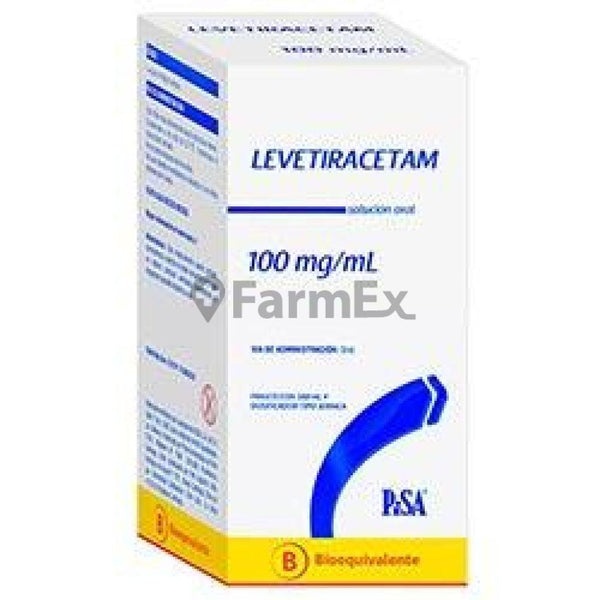
LEVETIRACETAM AUROVITAS 100 mg/ml ORAL SOLUTION

Ask a doctor about a prescription for LEVETIRACETAM AUROVITAS 100 mg/ml ORAL SOLUTION

How to use LEVETIRACETAM AUROVITAS 100 mg/ml ORAL SOLUTION
Introduction
Package Leaflet: Information for the User
Levetiracetam Aurovitas 100 mg/ml Oral Solution EFG
levetiracetam
Read all of this leaflet carefully before you or your child start taking this medicine, because it contains important information for you.
- Keep this leaflet, as you may need to read it again.
- If you have any further questions, ask your doctor or pharmacist.
- This medicine has been prescribed for you only. Do not pass it on to others. It may harm them, even if their signs of illness are the same as yours.
- If you get any side effects, talk to your doctor or pharmacist. This includes any possible side effects not listed in this leaflet. See section 4.
Contents of the pack
- What is Levetiracetam Aurovitas and what is it used for
- What you need to know before you take Levetiracetam Aurovitas
- How to take Levetiracetam Aurovitas
- Possible side effects
- Storage of Levetiracetam Aurovitas
- Contents of the pack and other information
1. What is Levetiracetam Aurovitas and what is it used for
Levetiracetam is an antiepileptic medicine (a medicine used to treat seizures in epilepsy).
Levetiracetam Aurovitas is used:
- on its own in adults and adolescents from 16 years of age with newly diagnosed epilepsy to treat a certain form of epilepsy. Epilepsy is a condition where the patient has fits (seizures). Levetiracetam is used to treat a form of epilepsy where the seizures initially only affect one side of the brain but may then spread to wider areas on both sides of the brain (partial onset seizures with or without secondary generalisation). Your doctor has prescribed levetiracetam for you to reduce the number of seizures.
- with other antiepileptic medicines to treat:
- partial onset seizures with or without secondary generalisation in adults, adolescents, children, and infants from 1 month of age.
- myoclonic seizures (short, shock-like jerks of a muscle or a group of muscles) in adults and adolescents from 12 years of age with juvenile myoclonic epilepsy.
- primary generalised tonic-clonic seizures (major fits, including loss of consciousness) in adults and adolescents from 12 years of age with idiopathic generalised epilepsy (a type of epilepsy that is thought to have a genetic cause).
2. What you need to know before you take Levetiracetam Aurovitas
Do not takeLevetiracetam Aurovitas
Warnings and precautions
Tell your doctor before you start taking levetiracetam:
Tell your doctor or pharmacist if any of the following side effects get worse or last more than a few days:
- abnormal thoughts, feeling irritable or reacting more aggressively than usual, or if you or your family and friends notice important changes in your mood or behaviour.
- worsening of epilepsy
Rarely, epileptic seizures may worsen or occur more frequently, mainly during the first month after starting treatment or increasing the dose.
In a very rare form of early-onset epilepsy (epilepsy associated with SCN8A mutations) that causes multiple types of epileptic seizures and loss of skills, you may notice that seizures persist or worsen during treatment.
If you experience any of these new symptoms while taking levetiracetam, see a doctor as soon as possible.
Children and adolescents
- Monotherapy with levetiracetam is not indicated in children and adolescents under 16 years of age.
Using Levetiracetam Aurovitas with other medicines
Tell your doctor or pharmacist if you are taking, have recently taken, or might take any other medicines.
Do not take macrogol (a medicine used as a laxative) for one hour before and one hour after taking levetiracetam, as it may reduce its effect.
Pregnancy, breastfeeding, and fertility
If you are pregnant or breastfeeding, think you may be pregnant, or are planning to have a baby, ask your doctor for advice before taking this medicine.
Levetiracetam should only be used during pregnancy if, after careful evaluation, your doctor considers it necessary. Do not stop your treatment without first discussing it with your doctor. The risk of birth defects for the baby cannot be completely excluded.
Breastfeeding is not recommended during treatment.
Driving and using machines
Levetiracetam may affect your ability to drive or use tools or machinery, as it may cause drowsiness. This is more likely at the start of treatment or when the dose is increased. You should not drive or use machinery until it is established that your ability to perform these activities is not affected.
Levetiracetam Aurovitascontains methyl parahydroxybenzoate (E 218) and propyl parahydroxybenzoate (E 216)
Levetiracetam oral solution, which contains methyl parahydroxybenzoate (E218) and propyl parahydroxybenzoate (E216), may cause allergic reactions (possibly delayed).
Levetiracetam oral solution also contains maltitol. If your doctor tells you that you have an intolerance to some sugars, contact your doctor before taking this medicine.
Propylene glycol
This medicine contains 20.27 mg of propylene glycol in each ml of oral solution. If the baby is less than 4 weeks old, consult your doctor or pharmacist, especially if the baby has been given other medicines that contain propylene glycol or alcohol.
Levetiracetam Aurovitas 100 mg/ml oral solution EFG contains sodium
This medicine contains less than 1 mmol of sodium (23 mg) per ml; this is, essentially, “sodium-free”.
3. How to take Levetiracetam Aurovitas
Always take this medicine exactly as your doctor or pharmacist has told you. If you are not sure, check with your doctor or pharmacist.
Levetiracetam must be taken twice a day, once in the morning and once in the evening, approximately at the same time each day.
Take the oral solution as instructed by your doctor.
Monotherapy(from 16 years of age)
Adults (≥ 18 years) and adolescents (from 16 years of age):
Measure the appropriate dose using the 10 ml syringe included in the pack for patients from 4 years of age onwards.
Recommended dose: Levetiracetam is taken twice a day, divided into two equal doses, each of 5 ml (500 mg) to 15 ml (1,500 mg).
When you start taking levetiracetam, your doctor will prescribe a lower dosefor two weeks before giving you the lowest daily dose.
Concomitant therapy
Dose in adults and adolescents (from 12 to 17 years):
Measure the appropriate dose using the 10 ml syringe included in the pack for patients from 4 years of age onwards.
Recommended dose:
Levetiracetam is taken twice a day, divided into two equal doses, each of 5 ml (500 mg) to 15 ml (1,500 mg).
Dose inchildren from 6 months of age onwards:
Your doctor will prescribe the most suitable pharmaceutical form of levetiracetam according to the age, weight, and dose.
For children from 6 months to 4 years, measure the appropriate dose using the 3 ml syringe included in the pack.
For children over 4 years, measure the appropriate dose using the 10 ml syringe included in the pack.
Recommended dose: Levetiracetam is taken twice a day, divided into two equal doses, each of 0.1 ml (10 mg) to 0.3 ml (30 mg) per kilogram of the child's body weight (see dose examples in the table below).
Dose in children from 6 months of age onwards:
Weight | Initial dose: 0.1 ml/kg twice a day | Maximum dose: 0.3 ml/kg twice a day |
6 kg | 0.6 ml twice a day | 1.8 ml twice a day |
8 kg | 0.8 ml twice a day | 2.4 ml twice a day |
10 kg | 1 ml twice a day | 3 ml twice a day |
15 kg | 1.5 ml twice a day | 4.5 ml twice a day |
20 kg | 2 ml twice a day | 6 ml twice a day |
25 kg | 2.5 ml twice a day | 7.5 ml twice a day |
From 50 kg | 5 ml twice a day | 15 ml twice a day |
Dosing in infants (from 1 month to less than 6 months):
For infants from 1 month to less than 6 months, measure the appropriate dose using the 1 mlsyringe included in the pack.
Recommended dose: Levetiracetam is taken twice a day, divided into two equal doses, each of 0.07 ml (7 mg) to 0.21 ml (21 mg) per kilogram of the infant's body weight (see dose examples in the table below).
Dosing in infants (from 1 month to less than 6 months):
Weight | Initial dose: 0.07 ml/kg twice a day | Maximum dose: 0.21 ml/kg twice a day |
4 kg | 0.3 ml twice a day | 0.85 ml twice a day |
5 kg | 0.35 ml twice a day | 1.05 ml twice a day |
6 kg | 0.45 ml twice a day | 1.25 ml twice a day |
7 kg | 0.5 ml twice a day | 1.5 ml twice a day |
Method of administration:
After measuring the correct dose with a suitable syringe, levetiracetam can be taken by diluting the oral solution in a glass of water or in a baby bottle. You can take levetiracetam with or without food. After oral administration of levetiracetam, a bitter taste may be noticed.
Instructions for correct administration:
 Open the bottle: press the stopper and unscrew it counterclockwise (figure 1)
Open the bottle: press the stopper and unscrew it counterclockwise (figure 1)
- Separate the syringe adapter (figure 2). Insert the adapter into the neck of the bottle (figure 3). Make sure it is securely attached.
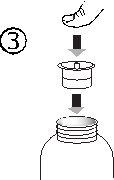
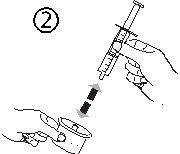
- Take the syringe and insert it into the adapter opening (figure 4). Turn the bottle upside down (figure 5).
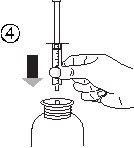

- Fill the syringe with a small amount of solution by lowering the plunger (figure 5A) and then raising it to eliminate any possible bubbles (figure 5B). Lower the plunger to the graduation mark corresponding to the prescribed dose in milliliters (ml) (figure 5C).


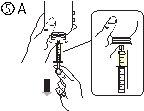
- Turn the bottle right side up (figure 6A). Remove the syringe from the adapter (figure 6B).
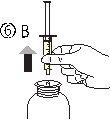

- Empty the contents of the syringe into a glass of water or a baby bottle, lowering the plunger to the end of the syringe (figure 7).

- Drink the entire contents of the glass or baby bottle.
- Close the bottle with the plastic screw cap.
- Wash the syringe only with water (figure 8).

Duration of treatment:
- Levetiracetam is used as a chronic treatment. You should continue treatment with levetiracetam for the time indicated by your doctor.
- Do not stop your treatment without your doctor's advice, as your seizures may increase.
If you take more Levetiracetam Aurovitas than you should
Possible side effects of an overdose of levetiracetam are drowsiness, agitation, aggression, decreased alertness, inhibition of breathing, and coma.
Contact your doctor if you have taken more oral solution than you should. Your doctor will establish the best possible treatment for the overdose.
If you forget to take Levetiracetam Aurovitas:
Contact your doctor if you have missed one or more doses. Do not take a double dose to make up for the missed doses.
If you stop treatment with Levetiracetam Aurovitas:
Stopping treatment with levetiracetam should be done gradually to avoid an increase in seizures. If your doctor decides to stop your treatment with levetiracetam, he/she will give you instructions for the gradual withdrawal of levetiracetam.
If you have any other questions about the use of this medicine, ask your doctor or pharmacist.
4. Possible Adverse Effects
Like all medicines, levetiracetam can cause adverse effects, although not all people suffer from them.
Inform your doctor immediately, or go to the emergency department of your nearest hospital if you experience:
- weakness, dizziness, or difficulty breathing, as these may be signs of a severe allergic reaction (anaphylactic);
- swelling of the face, lips, tongue, or throat (Quincke's edema);
- flu-like symptoms and rash on the face followed by a prolonged rash with high temperature, elevated liver enzyme levels in blood tests, and an increase in a type of white blood cells (eosinophilia), enlarged lymph nodes, and the involvement of other body organs (Drug Reaction with Eosinophilia and Systemic Symptoms (DRESS));
- symptoms such as low urine output, fatigue, nausea, vomiting, confusion, and swelling of legs, arms, or feet, as these may be signs of sudden renal function decrease;
- a skin rash that can form blisters and may appear as small targets (dark central spots surrounded by a paler area, with a dark ring around the edge) (erythema multiforme);
- a widespread rash with blisters and skin peeling, especially around the mouth, nose, eyes, and genitals (Stevens-Johnson syndrome);
- a more severe form that causes skin peeling on more than 30% of the body surface (toxic epidermal necrolysis);
- signs of severe mental changes or if someone around you notices signs of confusion, somnolence (drowsiness), amnesia (memory loss), memory impairment (forgetfulness), abnormal behavior, or other neurological signs including involuntary or uncontrolled movements. These may be symptoms of encephalopathy.
The most frequently reported adverse effects are nasopharyngitis, somnolence (feeling of sleep), headache, fatigue, and dizziness. Adverse effects such as feeling of sleep, feeling of weakness, and dizziness may be more frequent when treatment is initiated or the dose is increased. However, these adverse effects should decrease over time.
Very Common: may affect more than 1 in 10 people
- nasopharyngitis;
- somnolence (feeling of sleep), headache.
Common: may affect up to 1 in 10 people
- anorexia (loss of appetite);
- depression, hostility or aggression, anxiety, insomnia, nervousness or irritability;
- seizures, balance disorder, dizziness (feeling of instability), lethargy (lack of energy and enthusiasm), tremor (involuntary tremor);
- vertigo (feeling of rotation);
- cough;
- abdominal pain, diarrhea, dyspepsia (indigestion), vomiting, nausea;
- skin rash;
- asthenia/fatigue (feeling of weakness).
Uncommon: may affect up to 1 in 100 people
- decrease in platelet count, decrease in white blood cells;
- weight loss, weight gain;
- suicidal attempt and suicidal thoughts, mental disorders, abnormal behavior, hallucinations, anger, confusion, panic attack, emotional instability/mood changes, agitation;
- amnesia (memory loss), memory impairment (lack of memory), abnormal coordination/ataxia (altered movement coordination), paresthesia (tingling), attention disorders (loss of concentration);
- diplopia (double vision), blurred vision;
- elevated/abnormal liver function test values;
- hair loss, eczema, itching;
- muscle weakness, myalgia (muscle pain);
- injury.
Rare: may affect up to 1 in 1,000 people
- infection;
- decrease in all types of blood cells;
- severe allergic reactions (DRESS, anaphylactic reaction (severe and important allergic reaction), Quincke's edema (swelling of face, lips, tongue, and throat));
- decrease in sodium concentration in blood;
- suicide, personality disorders (behavioral problems), abnormal thinking (slow thinking, difficulty concentrating);
- delirium;
- encephalopathy (see subsection "Inform your doctor immediately" for a detailed description of symptoms);
- epileptic seizures may worsen or occur more frequently;
- uncontrolled muscle spasms affecting the head, torso, and limbs, difficulty controlling movements, hyperkinesia (hyperactivity);
- change in heart rhythm (Electrocardiogram);
- pancreatitis (inflammation of the pancreas);
- liver failure, hepatitis (inflammation of the liver);
- sudden decrease in renal function;
- skin rash, which can lead to blisters that may appear as small targets (dark central spots surrounded by a paler area, with a dark ring around the edge) (erythema multiforme), a widespread rash with blisters and skin peeling, especially around the mouth, nose, eyes, and genitals (Stevens-Johnson syndrome), and a more severe form that causes skin peeling on more than 30% of the body surface (toxic epidermal necrolysis);
- rhabdomyolysis (muscle tissue breakdown) and increased creatine phosphokinase in blood. Prevalence is significantly higher in Japanese patients compared to non-Japanese patients;
- limping or difficulty walking;
- combination of fever, muscle stiffness, unstable blood pressure and heart rate, confusion, low level of consciousness (may be signs of a disorder called malignant neuroleptic syndrome). Prevalence is significantly higher in Japanese patients compared to non-Japanese patients.
Very Rare: may affect up to 1 in 10,000 people
- unwanted or repetitive thoughts or feelings, or the urge to do something over and over again (obsessive-compulsive disorder).
Reporting of Adverse Effects
If you experience any type of adverse effect, consult your doctor or pharmacist, even if it is a possible adverse effect that is not listed in this prospectus. You can also report them directly through the Spanish Pharmacovigilance System for Human Use Medicines: https://www.notificaram.es. By reporting adverse effects, you can contribute to providing more information on the safety of this medicine.
5. Storage of Levetiracetam Aurovitas
Keep this medicine out of sight and reach of children.
Do not use this medicine after the expiration date stated on the carton after CAD. The expiration date is the last day of the month indicated.
This medicine does not require special storage conditions.
Do not use after 7 months of opening the package.
Medicines should not be disposed of via wastewater or household waste. Deposit the packages and medicines you no longer need at the SIGRE point in your pharmacy. In case of doubt, ask your pharmacist how to dispose of packages and medicines you no longer need. This way, you will help protect the environment.
6. Package Contents and Additional Information
Composition ofLevetiracetam Aurovitas
- The active ingredient is levetiracetam. Each ml contains 100 mg of levetiracetam.
- The other components are: liquid maltitol (E-965), glycerol (E-422), propylene glycol, methyl parahydroxybenzoate (E-218), propyl parahydroxybenzoate (E-216), citric acid monohydrate, sodium citrate, acesulfame potassium (E-950), mafco magnasweet (glycerin, ammonium glycyrrhizate), grape flavor (flavorings, propylene glycol, ascorbic acid), purified water.
Appearance of the Product and Package Contents
Levetiracetam Aurovitas 100 mg/ml oral solution EFG is a clear, colorless liquid with a grape flavor.
The 300 ml glass bottle (type III) of Levetiracetam Aurovitas (for children from 4 years of age, adolescents, and adults) with a white child-resistant cap, is packaged in a cardboard box with a 10 ml oral syringe (graduated every 0.25 ml) and a syringe adapter.
The 150 ml glass bottle (type III) of Levetiracetam Aurovitas (for infants and young children from 6 months to less than 4 years of age) with a white child-resistant cap, is packaged in a cardboard box with a 3 ml oral syringe (graduated every 0.1 ml) and a syringe adapter.
The 150 ml glass bottle (type III) of Levetiracetam Aurovitas (for infants from 1 month to less than 6 months of age) with a white child-resistant cap, is packaged in a cardboard box with a 1 ml oral syringe (graduated every 0.05 ml) and a syringe adapter.
Only some package sizes may be marketed.
Marketing Authorization Holder and Manufacturer
Marketing Authorization Holder:
Aurovitas Spain, S.A.U.
Avda. de Burgos, 16-D
28036 Madrid
Spain
Manufacturer:
APL Swift Services (Malta) Limited
HF26, Hal Far Industrial Estate, Hal Far
Birzebbugia, BBG 3000
Malta
This medicine is authorized in the Member States of the European Economic Area under the following names:
Spain: Levetiracetam Aurovitas 100 mg/ml oral solution EFG
Italy: Levetiracetam Aurobindo Pharma Italia
Malta: Levetiracetam Aurobindo 100 mg/ml oral solution
Portugal: Levetiracetam Aurovitas
Date of the Last Revision of this Prospectus:April 2025
Detailed information about this medicine is available on the website of the Spanish Agency for Medicines and Health Products (AEMPS) (http://www.aemps.gob.es)

How much does LEVETIRACETAM AUROVITAS 100 mg/ml ORAL SOLUTION cost in Spain ( 2025)?
The average price of LEVETIRACETAM AUROVITAS 100 mg/ml ORAL SOLUTION in December, 2025 is around 56.64 EUR. Prices may vary depending on the region, pharmacy, and whether a prescription is required. Always check with a local pharmacy or online source for the most accurate information.
- Country of registration
- Average pharmacy price56.64 EUR
- Active substance
- Prescription requiredYes
- Manufacturer
- This information is for reference only and does not constitute medical advice. Always consult a licensed doctor before taking any medication. Oladoctor is not responsible for medical decisions based on this content.
- Alternatives to LEVETIRACETAM AUROVITAS 100 mg/ml ORAL SOLUTIONDosage form: INJECTABLE PERFUSION, 100 mgActive substance: levetiracetamManufacturer: Ucb PharmaPrescription requiredDosage form: INJECTABLE PERFUSION, 100 mg/mlActive substance: levetiracetamManufacturer: Ucb PharmaPrescription requiredDosage form: ORAL SOLUTION/SUSPENSION, 100 mgActive substance: levetiracetamManufacturer: Ucb PharmaPrescription required
Alternatives to LEVETIRACETAM AUROVITAS 100 mg/ml ORAL SOLUTION in other countries
The best alternatives with the same active ingredient and therapeutic effect.
Alternative to LEVETIRACETAM AUROVITAS 100 mg/ml ORAL SOLUTION in Poland
Alternative to LEVETIRACETAM AUROVITAS 100 mg/ml ORAL SOLUTION in Ukraine
Online doctors for LEVETIRACETAM AUROVITAS 100 mg/ml ORAL SOLUTION
Discuss dosage, side effects, interactions, contraindications, and prescription renewal for LEVETIRACETAM AUROVITAS 100 mg/ml ORAL SOLUTION – subject to medical assessment and local rules.







